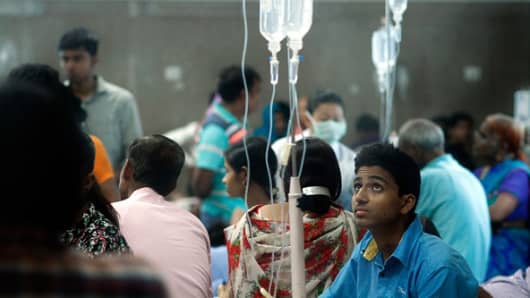
Four days after Manoj Sharma's 6-year-old son first fell ill with dengue fever, a mosquito-borne disease rampant in urban India, his body showed signs of shock: a plunging platelet count, vomiting and labored breathing. At 2 a.m. on Sept. 13, Mr. Sharma suffered a shock of his own, learning that the private clinic that had given his son a vital platelet transfusion — with a $182 bill — lacked the resources to provide further treatment.
He spent the next three hours ferrying his wife and son on the back of his scooter to different hospitals that he said were unable, because of overcrowding, to treat the boy.
Finally, the nonprofit Holy Family Hospital admitted his son, Aman, who spent several hours in the intensive care unit but ultimately died. All told, Mr. Sharma had taken his son to five hospitals in six days, secured two platelet transfusions and a stay in an intensive care unit, paying about 70,000 rupees — around $1,100 — with loans from his mother and brother.
"I was numb," Mr. Sharma said. "He died before my eyes."
During the annual dengue season, roughly from August to November, stories like Aman's circulate through the city. The dengue outbreak in Delhi appears to be the worst in years — as of Thursday, more than 9,000 registered cases and 30 deaths, the highest numbers since 2006. The stories have a depressing sameness, describing families looking for lifesaving treatment left on their own to navigate a dizzying array of public and private providers.
In September, news reports told of the parents of a 7-year-old dengue victim in Delhi who jumped to their deaths from their fourth-story apartment after reportedly being turned away from five private hospitals. After that, the government demanded an explanation for the five hospitals' actions and announced a series of compliance measures — a 600 rupee ceiling for lab tests, about $9, an increase in available beds until November and a request not to turn away serious dengue patients.
Read MoreIndian FinMin sees India as a new world engine for growth
Experts, however, say privatized health care is only part of the problem, and reflects the shortcomings of an overburdened public system and the inadequacy of the government's preventive measures.
"The health infrastructure hasn't expanded as much as the population has expanded," said A. Venkat Raman, a professor of management studies at the University of Delhi, who specializes in health care. Nevertheless, he said, the recent cases could have been avoided if there was a process of referrals at public hospitals so that patients could be directed to the hospitals, private or public, where they could receive treatment.
New Delhi hospitals have been inundated by patients this season, in what officials and experts called a public panic over dengue, fanned by the news reports.
In a ward filled with patients waiting for dengue test results at the government-run Safdarjung Hospital in South Delhi last month, there were two patients for almost every bed and few doctors or nurses. Electric lamps to kill mosquitoes had been installed in an effort to try to prevent the spread of the infection. When a single doctor entered the ward, he affixed an IV to a semiconscious patient, then quickly disappeared.
In another building, a ward overflowed with confirmed dengue patients, many of whom were forced to camp out on sheets in the corridor. One of those patients, Somkala Kumar, 23, who contracted dengue last month, had come to the hospital with a dangerously low platelet count. It took a day for her to be transferred to the ward, where she was now awaiting treatment. Her arms and legs were covered with red spots, a sign of hemorrhage.
"The doctor who comes only occasionally does not come to each person personally," said her husband, Vinod Kumar. "She just comes and talks to everyone at large. They do not listen or even check as to whether my wife has these red spots."
More from The New York Times:
Mob Attack, Fueled by Rumors of Cow Slaughter, Has Political Overtones in India
Southeast Asia, Choking on Haze, Struggles for a Solution
Pakistani Singer's Concerts in India Are Canceled After Shiv Sena Protests
Though care at private hospitals is often preferable when available, the costs at for-profit treatment facilities can be exorbitant for poor families. Even at that, experts say, for-profit hospitals are reluctant to take on dengue cases because of the low profit margins associated with widespread diseases.
Mr. Raman said he did not believe "the people who have invested in private hospitals are waiting to treat the people with dengue, malaria or typhoid."
He added, "My gut feeling would be if dengue is a public health kind of epidemic or a public health kind of menace, public hospitals should be the first ones to be called."










 Topic Options
Topic Options

 Post Options
Post Options Thanks(0)
Thanks(0)


